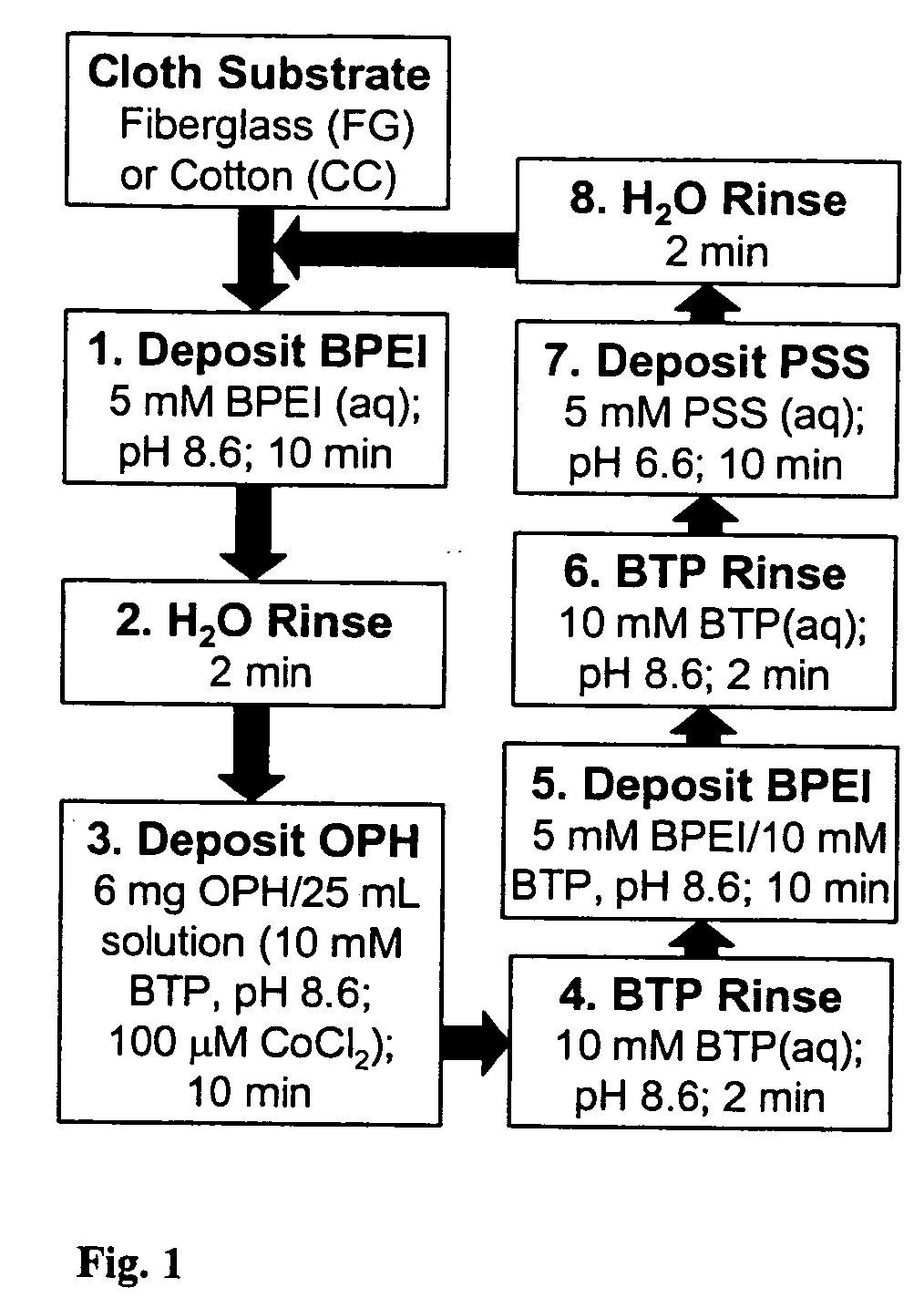Catalytic enzyme-modified textiles for active protection from toxins
a technology of catalytic enzymes and textiles, applied in weaving, fire extinguishers, peptide/protein ingredients, etc., can solve the problems of only one useful life cycle, chemical effects may be more harmful, and bulky materials used in barrier protection, etc., to achieve superior catalytic activity of enzymes, simple and effective multi-layer formation, and no harm to the environment
- Summary
- Abstract
- Description
- Claims
- Application Information
AI Technical Summary
Benefits of technology
Problems solved by technology
Method used
Image
Examples
example 1
Fabrication of Polyelectrolyte-OPH Enzyme Multilayer on Fiberglass Cloth by Dip Coating
[0048] This example demonstrates the preparation of a polyelectrolyte-enzyme multilayer containing a single layer of the OPH enzyme on a woven fiberglass cloth sample by the dip coating method.
[0049] Two circular samples of fiberglass cloth of ˜3 inch diameter each were cut from the roll of cloth obtained from the supplier (Hexcel) and cleaned using the Standard Cleaning Protocol. Separate plastic cylindrical 50 mL centrifuge tubes (Falcon BD), each of length ˜4.5 inches, were used to secure the samples. The centrifuge tube diameter was constant at ˜1.25 inches over a 4 inch length of the tube, rapidly tapering to ˜0.25 inches at the bottom of the tube. Each tube was prepared for use by drilling a hole through the 0.25 inch diameter plastic section of the bottom of the tube to equalize air pressure and permit free flow of solution into and out of the tube during sample treatment. The freshly cle...
example 2
MPT Hydrolysis Activity of Multilayer-coated Fiberglass Cloth Containing a Single OPH Enzyme Layer Prepared by Dip Coating
[0052] This example demonstrates that fiberglass cloth dip coated with a multilayer polyelectrolyte film encapsulating a single layer of OPH enzyme is capable of hydrolyzing MPT
[0053] The control FG / BPEI (weight 80 mg) and sample FG / BPEI / OPH / BPEI cloths (weight 82 mg) prepared in Example 1 were removed from the refrigerator and allowed to warm to room temperature. Each cloth was then fully immersed in a separate beaker containing 100 mL of stirred Stock MPT solution for 22 hours at room temperature (23±2° C.). The clear and colorless MPT solution containing the FG / BPEI / OPH / BPEI sample cloth developed a clear yellow color with increasing time. Little, if any, color was observed in the MPT solution containing the FG / BPEI control cloth. The sample and control cloths were then removed from the MPT solutions, rinsed carefully, blown dry with the filter nitrogen gas ...
example 3
Reproducibility of Fabrication and Hydrolytic Activity of Multilayer-Coated Fiberglass Cloth Containing a Single OPH Enzyme Layer Prepared by Dip Coating
[0054] This experiment illustrates the degree with which the multilayer-coated fiberglass cloths having MPT hydrolysis activity can be fabricated by the dip coating method.
[0055] The fabrication procedure described in Example 1 was repeated 3 times using fresh samples of fiberglass cloth in each case. Fresh solutions were used to coat the samples with encapsulated OPH enzyme towards hydrolysis of MPT as described in example 2. Once again, the 3 FG / BPEI control clothes produced only ˜0.8 μM PNP in each case, indicating negligible hydrolysis of the MPT solution. The separately prepared FG / BPEI / OPH / BPEI sample cloths produced ˜15 μM PNP, ˜16 μM PNP, and ˜15 μM PNP in good agreement with the 18 μM PNP produced using the corresponding sample from Example 2. The average activity exhibited by the 4 sample cloths of Examples 2 and 3 is 16...
PUM
| Property | Measurement | Unit |
|---|---|---|
| pH | aaaaa | aaaaa |
| thickness | aaaaa | aaaaa |
| volume | aaaaa | aaaaa |
Abstract
Description
Claims
Application Information
 Login to View More
Login to View More - R&D
- Intellectual Property
- Life Sciences
- Materials
- Tech Scout
- Unparalleled Data Quality
- Higher Quality Content
- 60% Fewer Hallucinations
Browse by: Latest US Patents, China's latest patents, Technical Efficacy Thesaurus, Application Domain, Technology Topic, Popular Technical Reports.
© 2025 PatSnap. All rights reserved.Legal|Privacy policy|Modern Slavery Act Transparency Statement|Sitemap|About US| Contact US: help@patsnap.com


